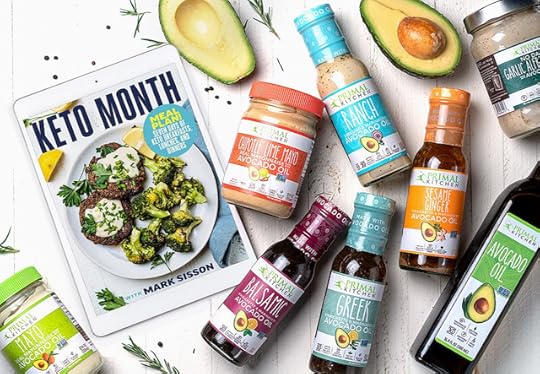Mark Sisson's Blog, page 88
December 1, 2019
Cinnamon Tea Cranberry Muffins
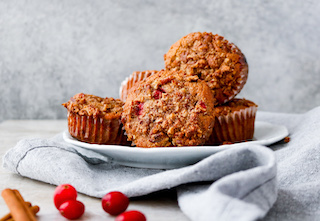 A big thank you to the good folks at Pique Tea for today’s awesome seasonal recipe. They’ve got a nice holiday deal going for the tea lover in your life (or yourself). Purchase one of their curated bundles and get a free box of their Jasmine Tea + free shipping. (Trust me, it’s good.) Enjoy, folks, and I hope you’re enjoying the holiday weekend!
A big thank you to the good folks at Pique Tea for today’s awesome seasonal recipe. They’ve got a nice holiday deal going for the tea lover in your life (or yourself). Purchase one of their curated bundles and get a free box of their Jasmine Tea + free shipping. (Trust me, it’s good.) Enjoy, folks, and I hope you’re enjoying the holiday weekend!
These cinnamon spiced muffins are a Paleo-friendly way to curb a sweet craving morning or night. They’re finished with a crunchy candied pecan topping using coconut sugar and are full of tangy fresh cranberries for balanced flavor.
Against the Grain
Almond flour stands in effortlessly for wheat flour in Paleo recipes for a gluten-free muffin that with a fluffy texture. Blanched almond flour is made from almonds that have the skin removed, resulting in a lighter texture. Almond flour can also be used in pie crust, cake, brownies and even bread in place of all-purpose flour. The fat content in this flour keeps baked goods moist with a subtle nutty flavor. Almond flour is also high in protein, helping to keep you feeling full.
Spice Things Up
Adding to the flavor profile of these muffins is an unexpected yet welcome ingredient; cinnamon fasting tea. This tea is is earthy with a noticeable aroma and flavor of cinnamon. Hints of bergamot and citrus notes. All of these flavors pair well with the cranberries, vanilla and ground cinnamon in the muffins and also add an extra element of depth that separates this recipe from other muffins.
To top off the muffins, a buttery, coconut sugar and pecan crumble is sprinkled on top of the muffin batter. As the muffins bake, the pecans toast and intensify their flavor and crunchy nature for a not-too-sweet candied coating on each muffin.
Every great muffin needs a warm cup of tea to wash it down. Cinnamon fasting tea combined with raw honey is both refreshing and soothing alongside the hearty muffins.
Just a few benefits of this cinnamon-infused muffin and tea combination include…
May help support healthy blood sugar levels
Cranberry may help support proper kidney function
Cinnamon may help increase satiety and promote a sense of calm
Almond consumption may help support healthy weight.
Cinnamon Cranberry Muffins
Total Time: 42 minutes (10 for prep, 32 for baking)
Servings: 8
Ingredients:
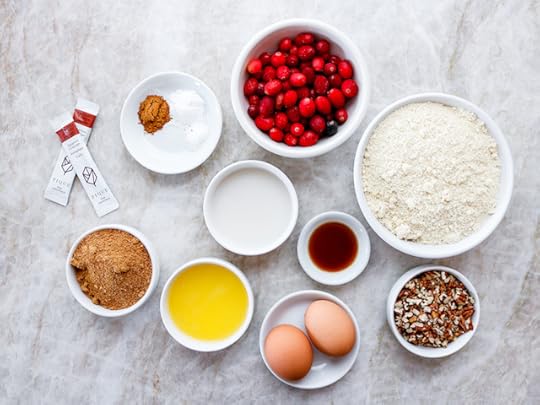
For Muffins:
2 cups blanched almond flour
2 large pasture raised eggs
1/2 cup coconut sugar
2 sachets Pique Cinnamon Herbal Fasting Tea
1 tsp cinnamon
1 tsp baking powder
1/4 tsp sea salt
1/3 cup melted unsalted grass fed butter
1/3 cup unsweetened almond milk
2 tsp vanilla extract
3/4 cup fresh cranberries
For Pecan Crumble Topping (optional):
1/2 cup chopped raw pecans
2 tbsp blanched almond flour
2 tbsp melted unsalted grass fed butter
1 tbsp coconut sugar
1/2 tsp cinnamon
Instructions:
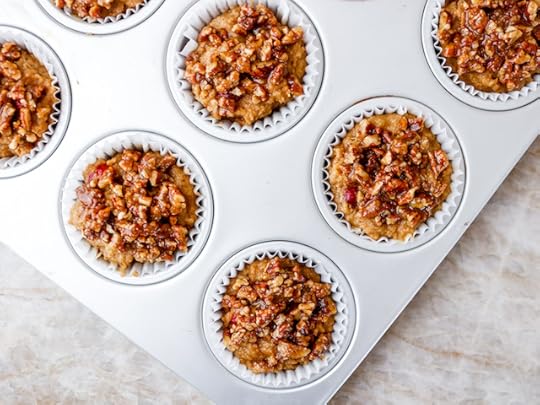
Preheat oven to 350ºF and line 8 muffin tins with paper liners. In a small mixing bowl, stir together almond flour, coconut sugar, cinnamon, Pique cinnamon fasting tea, baking powder and sea salt, breakup up and clumps. In a separate large mixing bowl, whisk together eggs, almond milk, and vanilla extract. Add melted butter and stir to incorporate. Gradually stir dry ingredients into wet until just combined. Fold in cranberries.
In a small bowl, mix together ingredients for pecan topping.
Scoop batter into muffin tins. Evenly scatter pecan topping over each muffin. Bake for 30-32 minutes or until muffins are set and toothpick inserted comes out mostly clean with a few moist crumbs. Cool muffins in pan at room temperature for 10 minutes. Transfer to a wire rack and cook an additional 15 minutes.

For Cinnamon-Honey Fasting Tea
Ingredients:
1 ½ cups boiling water
1 sachet Pique Cinnamon Herbal Fasting Tea
1 tbsp raw honey (optional)
Instructions:
Dissolve tea in boiling water in a large mug. Stir in raw honey. Sip and enjoy!

Thanks again to our friends at Pique Tea for the recipes today. Check out their fun gift guide and grab your free carton of their best-selling Jasmine Tea with the purchase of any bundle (including the cinnamon tea used in the recipes) now through 12/20/19.

The post Cinnamon Tea Cranberry Muffins appeared first on Mark's Daily Apple.



November 29, 2019
Weekly Link Love — Edition 57

Research of the Week
Eating peanuts before one year of age may protect against peanut allergy.
High levels of de novo lipogenesis-derived fatty acids linked to heart disease.
Oyster farming is environmentally congruent.
Given ad libitum access to food, dogs prioritize fat and protein over carbs.
New Primal Blueprint Podcasts

Episode 391: Martin Silva: Host Elle Russ chats with Martin Silva, a coach who’s been training and body sculpting since age 13 and today helps people discover their health, fitness, and optimal body composition.

Primal Health Coach Radio, Episode 36: Laura and Erin chat with Niraj Naik about using breathwork to restore and strengthen your default state.
Each week, select Mark’s Daily Apple blog posts are prepared as Primal Blueprint Podcasts. Need to catch up on reading, but don’t have the time? Prefer to listen to articles while on the go? Check out the new blog post podcasts below, and subscribe to the Primal Blueprint Podcast here so you never miss an episode.
Media, Schmedia
Why are younger Americans dying?
Should obese people hibernate through winter?
Interesting Blog Posts
How controlled burns might beat back tick infestations.
Social Notes
This is athleticism.
Why Thanksgiving is the most Primal holiday.
Everything Else
Paleolithic hunters in Mexico lured mammoths into traps.
Ancient foragers in Puerto Rico barbecued clams.
This is athleticism.
A classic video from Kelly Starrett: Conquering the load order error in the deadlift.
Things I’m Up to and Interested In
Exclusive interview I did: With Dave Asprey. Just order a copy of his book and submit the receipt for access.
They’re just now realizing this?: Prevention of cavities is more effective than treating cavities.
Marathon variety I can get behind: The one where you run one mile every hour.
I’m not surprised: Adhering to indigenous cultural traditions helps indigenous children’s outcomes.
This is a powerful story: 82-year-old female bodybuilder beats up home invader.
Question I’m Asking
Why aren’t you giving up coffee in favor of sunning your perineum?
Recipe Corner
Crispy roast potatoes: if you’re going to eat potatoes, make them as crispy as can be.
Low-carb (relatively) sweet potato pumpkin pie.
Time Capsule
One year ago (Nov 23– Nov 29)
An Amazing Development for the Primal Movement – The big news from a year ago.
Why an “Ab Routine” Isn’t Necessary (and What I Do Instead)– My paddling habit.
Comment of the Week
“It’s absolutely a combination. It takes individual action, but it also takes creating an environment. I hear you on the cookies. For most of my life I couldn’t resist eating sugar. What worked was keeping it out of the house. If it wasn’t there, I couldn’t eat it. Testing my willpower by having it in the house never worked. Changing my environment so that sugar wasn’t easily available is what did the trick.
And that’s what I’m suggesting as the environmental strategy for society at large. Make it more expensive. Make it harder to find. Make it socially unacceptable. It may be that addicted individuals can’t or won’t quit. But there will be fewer new ones to start. We didn’t rely on individual willpower to reduce smoking — and we had 350 years of experience to show that didn’t work — but changing the environment has worked pretty well.”
– The problem is that the people with the (dubious) power to change society from the top down don’t believe in our solutions, Mark E. Field.

The post Weekly Link Love — Edition 57 appeared first on Mark's Daily Apple.



November 28, 2019
Happy Thanksgiving
 Per Primal tradition, the bees and I are off for the day.
Per Primal tradition, the bees and I are off for the day.
I’ve said before that I consider Thanksgiving to be the most Primal of holidays. The elevated act of preparing and sharing a traditional meal is about as basic—and sacred—as human ceremony gets. It’s like gathering around a fire together. We bask in the comfort of ritual and cycle this time of year. We offer thanks for the year’s blessings.
Each year I say it, and each year I’m filled with the truth of it: I look to this community with heartfelt gratitude. Thank you for reading, for sharing, for contributing. Thank you for carrying the message of health and for supporting each other here.
Today I wish each of you the very best—of health and happiness. However you’re celebrating today, enjoy your holiday, everyone.

The post Happy Thanksgiving appeared first on Mark's Daily Apple.



November 27, 2019
Late To the Healthy Living Game? 10 Essential Tips Making the Transition to Better Health
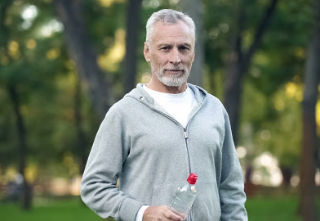 Many people get to age 60 or so and, if they haven’t lived a healthy, active life up to that point, assume it’s too late for them. After all, things only get harder the older you get. You’ve got aches and pains. Your doc is always reminding you about your weight. Things creak and crack. You look wistfully at the gym you pass by every day, thinking to yourself, “It would never work.”
Many people get to age 60 or so and, if they haven’t lived a healthy, active life up to that point, assume it’s too late for them. After all, things only get harder the older you get. You’ve got aches and pains. Your doc is always reminding you about your weight. Things creak and crack. You look wistfully at the gym you pass by every day, thinking to yourself, “It would never work.”
At least, that’s how most people deal with getting old: they lament their “inability” to do anything about it as oblivion approaches and overtakes them.
Forget all that. While you can’t turn back the chronological clock, you can “de-age” yourself by engaging in the right diet, exercise, and lifestyle modifications. So—how?
Realize That It’s Never Too Late
The scientific literature is rife with examples of older individuals making changes to their lifestyle, diet, and exercise and seeing great results.
How about 68-year-olds still getting gains from strength training?
Older women switching to high-fatty-meat or high-cheese diets and enjoying better heart health.
Verifiable examples (or “anecdotes”) from people online are also available. Like PD Mangan, who went from this to this. That’s not impossible, or even difficult to achieve. What you need is the will and means and know-how—all freely available.
Know that it’s possible. Know that it’s probable. Know that your efforts will not be in vain.
Realize That It’s Your Fault—And Even If It’s Not, It’s Your Responsibility
I don’t care where you fall on the belief spectrum. It could be that “your body is a temple ordained by God and you’d be remiss to let it fall to ruin and in doing so fail your creator.” It could be that “your body was the work of hundreds of generations of ancestors who fought and suffered and scrounged and died to ensure you’d make it and to fail to maintain your health is a huge insult to their sacrifices.” It could be that “your body is the product of millions and billions of years of evolution through natural selection, a chance byproduct of a process that probability says shouldn’t have even happened, and you’re going to waste it?”
However you approach it, what matters is that you have a remarkable body (and mind) that deserves your attention, care, maintenance and nourishment. Only you can do anything about it. Maybe you were fed bad food as a kid and bad info as an adult (this is most people). Doesn’t matter. You still have to own it and take the steps necessary to improve your condition. Responsibility means ability to respond. Claim it.
Eat More Protein
If you’re over 50, you need more protein than you think.
If you’re over 50, your ability to utilize protein isn’t as good as it used to be.
If you’re over 50, you need more protein to do the same job as a person 25 years younger.
If you’re over 65, the supposed negative relationship between meat and mortality the “experts” are always crowing about reverses, magically becoming a positive relationship.
And if one of your issues is trouble losing body fat, more protein will also help you beat back exaggerated hunger and keep food intake low enough to lose weight. Many people in the ancestral community don’t like acknowledging this, but it’s true for a great many people: protein is the most satiating macronutrient.
Moreover, protein will help you lose body fat and retain (and even gain) the all-important lean muscle mass. Losing muscle when you’re over 50 is harder and harder to recover from.
The only catch is that if one of your “aging-related maladies” is kidney failure, you may have to slow things down and keep your protein intake low to moderate. Emphasis on “may.” Check with your doctor if that’s the case.
Get As Insulin Sensitive As You Can
The relationship between insulin signaling and aging is a bit unclear. What we know is that people with higher insulin sensitivity live longer and healthier lives. We know that insulin resistance is strongly linked to most degenerative diseases, like cancer, diabetes, sarcopenia, and osteoporosis (to name only a few). But researchers are always oscillating between “cause” and “effect.” Is insulin resistance a cause or a sign of aging? Are insulin sensitive people healthier into old age because they’re insulin sensitive, or are they insulin sensitive because they’re healthier?
I’m not sure it really matters. Either way, to become more insulin sensitive you have to do a bunch of things that will also make you healthier and age better like lifting weights, quitting overeating, taking more walks, doing more low level aerobic work, and regulating your carb intake.
I’ve always said that you should burn as little glucose as possible. The more you can rely on stored body fat for energy and daily maintenance, the better. Well, the more insulin sensitive you are, the less insulin you’ll have blunting your ability to liberate stored body fat, the more fat you’ll burn and the better you’ll age.
Walk Every Day
One of my favorite predictors of mortality in older people is walking speed: they ask people to walk at their normal speed and then track how fast they go. The slower the walk, the higher their risk of dying earlier. It’s my favorite because it’s so elegant. And no, actively forcing yourself to walk more briskly when you get tested won’t increase your longevity. But if you get up and walk every single day, walking will be second nature. Your walking speed will increase naturally, and it’s the natural increase in walking speed that presages a longer, healthier life.
Walking will also force you to get out and see and experience the world. It’ll lower your fasting blood glucose and postprandial blood glucose (hint: walk after meals). It will introduce novelty to your life and in doing so extend your time horizon.
Eat Tons Of Collagen
Collagen improves skin health, elasticity, and reduces wrinkling. This might sound superficial, but altering those “surface level” signs of aging indicates that you’re also modifying the internal aging markers.
Another reason to up your collagen intake is to balance out the meat you’re eating. As an older person, you’ll need to eat more meat to counter your suboptimal protein utilization. That means you need to process more methionine, which requires more glycine, which comes from collagen.
The easiest way to get collagen and hit a few birds with one stone is to eat lots of collagenous meats—shanks, skin, knuckles, oxtails, ears, snouts, feet, tendons. That way you get your muscle meat protein and collagen protein. Collagen protein powder is another option.
Lift Heavy Things To Build Your Musculoskeletal System
Exercise isn’t just good for your muscles and your heart. It’s also the only reliable way to build and maintain bone mineral density. But in order for exercise to improve bone mineral density, it must satisfy several requirements. It should be dynamic, not static. It needs to challenge you. It needs to challenge your muscles. In other words, you need to lift (relatively) heavy things. You need to progress in weight, intensity, and duration. It should be “relatively brief but intermittent.” No long drawn-out sessions that do nothing but overwork and overtrain you. Keep it short and intense. Also, the exercise should place an unusual loading pattern on the bones. That could be different movements, or increased resistance, as long as you’re introducing something “new” to the body; don’t just do the same old weights forever. Finally, for exercise to improve bone mineral density it must be supported by sufficient nutrition, especially calcium, vitamin D, sufficient protein, and vitamin K2.
Develop Your Balance Yesterday
The number one cause of death and degeneration after age 70 is falling and breaking something. You step out of the shower, slip, and break a hip, then never recover. You step off a curb and fall on your knee, breaking your femur, and never recover. Avoid this at all costs. Improve your balance as soon as possible.
Get a slackline: Keep it low to the ground, have a partner to help, or use something like a walking stick to support you. Focus on simply balancing rather than trying to walk.
Try standup paddling: Not only is it a great workout and a great time, paddling forces you to balance—constantly. And as long as you can swim, falling is totally safe.
Walk on uneven surfaces (carefully): Go for hikes, walk in the sand or in the grass, walk along cobblestone streets, walk on slopes.
Walk along curbs (very carefully).
Wear footwear that is as minimalist as you can handle (or just go barefoot if you’re up for it): The bottom of the foot is loaded with nerve endings that inform you and guide your balance as you make your way through the world. They help you subconsciously make those micro-adjustments to your posture and body position that make up “good balance.” A big clunky rubber sole blocks that out and cuts you off from your body.
Play Every Day
They say that when you stop moving, you start dying. I say when you stop playing, you start dying. We see this in dogs; once a dog no longer wants to play, chase the ball, roughhouse, or do the things he or she used to love doing, they’re on the way out. I firmly believe the same is true for people—just spread out across a longer timeline.
So have fun. Play sports. Try Ultimate Frisbee (my favorite).
Don’t forget about the mental games. Game nights. Crosswords in the morning (that’s what I do). Play cards. Do a weekly poker night with friends and make it a potluck.
What I’m not saying is that doing the crossword will stave off Alzheimer’s or make you smarter. What it will do is send the message to your brain and body that “this person hasn’t given up.” Ideally, your physical play will train your muscles, bones, and balance—that way you can satisfy all those requirements and have fun doing it.
Don’t Do It Alone
If you’re an older person reading this and actually preparing to make the changes necessary to be healthy and vigorous, you are a rare bird. Most of your peers have given up. Most have resigned themselves to being less healthy and less vigorous with every passing day. Don’t let that happen. Enlist a friend, a loved one, a peer. Not only will it give you another person to play, train, and walk with, but it will help you stay the course and enjoy doing it. It will also save another person—or at least give them the best chance they’ve got.
Those are the big tips. There are others, though. And for anyone interested in better health and longevity and more life in the years you have, Keto for Life, offers more information than I could fit here. All the points I covered today and many more are fleshed out and expanded upon twenty-fold.
But if you just focused on these 10 tips, you’d be pretty far along on your way to health (no matter what age you are).
That’s it for today, folks. Take care, drop your own tips down below, and have a great Thanksgiving!

The post Late To the Healthy Living Game? 10 Essential Tips Making the Transition to Better Health appeared first on Mark's Daily Apple.



November 26, 2019
6 Mind-Body Approaches for Menopause
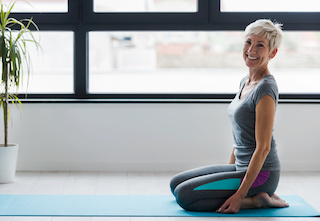 As we covered in Parts I and II of this series, during perimenopause and menopause women can experience a complex web of physical, psychological, and social symptoms.
As we covered in Parts I and II of this series, during perimenopause and menopause women can experience a complex web of physical, psychological, and social symptoms.
The treatment usually prescribed by doctors, hormone therapy (HT), is controversial and not appropriate for some women. I won’t get into the HT debate here—Mark did a great job covering the pros and cons recently. Suffice it to say that HT isn’t the answer for everyone, and it’s not a panacea by any means.
Whether or not they choose to go the HT route, many women desire additional support during perimenopause and beyond. For the sake of keeping this post from becoming a novella, I’m going to focus on mind-body therapies today.
This is not meant to be an exhaustive list of nonhormonal options, nor is it meant to try to dissuade you from trying HT. That’s a decision you have to make for yourself with your doctor. The approaches below can be used alone or in combination with other modalities, including HT.
As with any medical-adjacent tools, if you are considering any of the options here, take the time to educate yourself, talk to your doctor, and find qualified practitioners to help you implement these practices.
A Note Regarding Research Evidence…
Because so many women are interested in complementary or alternative approaches, there’s a fair amount of research into nonhormonal treatments. There are also important limitations.
A lot of the randomized control trials—experiments that are best for establishing causal effects—are small. There is considerable variability in research design, so it’s difficult to generalize across studies.
Participants in these studies tend to be white and well-educated. Since there are cross-cultural differences in the experience of menopause, we shouldn’t assume that the findings apply to all women. Likewise, a lot of the research focuses on women with a history of breast cancer because HT is generally contraindicated in this population. While the results of these studies probably generalize to other women, it would be great to have more data.
Finally, vasomotor symptoms—hot flushes and night sweats—are studied more than other types of symptoms. Though they are the most common complaint, many women do not experience debilitating vasomotor symptoms. They might, however, experience mood fluctuations, depression, sexual issues, memory problems, and more. We know less about how these approaches might help those women.
Nevertheless, I’ll highlight some of the potentially fruitful avenues you might explore. When possible, I’ll focus on systematic reviews and meta-analyses. They pool the results of multiple smaller studies to help a more reliable picture emerge.
Cognitive Behavioral Therapy (CBT)
In CBT, individuals are encouraged to explore how their thoughts (cognitions) affect feelings, behaviors, and physical symptoms. With help, they change their thoughts or beliefs about a situation to help manage their responses and improve coping skills.
Although there isn’t a ton of research on CBT for menopause, available studies are very promising. Whether or not CBT reduces the actual number of hot flushes—and the data here are mixed—CBT should work by changing women’s perceptions of their hot flushes. Multiple studies do find that after CBT women view their hot flushes as interfering less with daily life. As expected, they are also less bothered by them.
Women who see themselves as having less control over their hot flushes also tend to experience more distress. Changing their perceived control could be an effective intervention for improving quality of life. Indeed, in one study, 95 women received either group-based or self-help CBT. After therapy they reported feeling greater control over hot flushes and having better coping skills compared to women in a no-CBT control condition. Further analyses showed that women’s beliefs about control and coping predicted how problematic they found their hot flushes to be. (Having more positive beliefs about how hot flushes affect sleep also helped.)
Women who participated in CBT also experienced fewer sleep issues and insomnia as well as fewer depressive symptoms and sexual concerns. They also noticed less impairment at work. Positive results were found with in-person therapy, self-help programs, and telephone-based therapy. When studies included a follow-up assessment, the beneficial effects of CBT persisted for at least six months.
Mindfulness, Meditation and Relaxation Training
A cross-sectional study of 1744 women found that women with higher scores on a mindfulness assessment tended to report less severe menopausal symptoms. For women with higher life stress, this association was especially strong. The idea here is that when women are able to be present-focused and observe their symptoms without judgment, they are protected against some of the distress, and possibly the physical symptoms, associated with menopause.
Although some of the women in that survey are probably mindful by nature—lucky them—mindfulness is also a skill that can be learned and cultivated. Among the many reasons to do so, mindfulness and meditation training can apparently lessen menopausal symptoms.
For example, researchers assigned 110 women to either an intensive eight-week mindfulness-based stress reduction program or a control group. The women who received mindfulness training reported having less bothersome hot flushes, better sleep quality, less anxiety and stress, and greater overall quality of life compared to the control group. When the researchers followed participants over the next 11 weeks, these results persisted or became even stronger.
A few other studies found that women who receive mindfulness or meditation training report fewer and less bothersome hot flushes, improved sleep, and better psychological functioning, though the results have not consistently endured over time. However, when looking at more general relaxation training and paced breathing techniques, effects are minimal, at least for hot flushes.
Yoga
An ethnographic study of nine female yogi masters concluded that they tend to skate fairly easily through menopause. The authors concluded that menopausal women should be encouraged to practice yoga. Of course, in addition to yoga, these yogi masters’ lifestyles included “healthy food habits, adequate sleep, and the use of nature cure techniques (i.e., fasting, detoxification, selection of suitable food products, and living in well-ventilated houses) that facilitated the art of living in tune with nature.” This sounds pretty great, but can we give really yoga all the credit here?
Probably not. However, two recent meta-analyses did conclude that yoga offers small but significant relief from symptoms of all types: vasomotor, psychological (including depression), somatic (including fatigue and sleep disturbances), and urogenital. Women also report better overall well-being and quality of life after receiving yoga training.
In one study, a group of breast cancer survivors received twelve weeks of yoga and meditation instruction, and they were encouraged to practice daily at home. Compared to women in a control group (no instruction), they reported fewer symptoms and improved quality of life at the end of the twelve weeks and again when asked three months later. A later analysis found that many of the effects were mediated by improved self-esteem in the yoga group.
Note that most of the individual studies are small, and they employ different types of yoga practices. This might be considered a strength insofar as different practices have been shown to work, or a weakness in that it’s not clear if one approach is particularly effective.
Exercise
Cross-cultural surveys find that women who are more active tend to have an easier time with menopause. For example, two large surveys of Swedish women found that women who exercised at least once per week reported less intrusive symptoms than women who never exercised, and women who exercised more than three hours per week were significantly less likely to experience severe symptoms than their less active counterparts. Sedentary women in this Finnish study experienced more vasomotor, psychological, and somatic/pain symptoms than women who were at least somewhat active.
While promising, experimental studies have not yielded such favorable results. When women were assigned to “physical activity” conditions (often walking), some studies report improvements, but others find no improvements or even worsening symptoms (perhaps depending on women’s baseline fitness). Multiple reviews have concluded that there is no systematic effect of exercise, particularly not for vasomotor symptoms.
Does that mean menopausal women shouldn’t exercise? Obviously no. It’s clear that being active—or at least not being sedentary—is important for overall health, and it probably helps menopausal women through the transition. However, there isn’t enough research to know what types of exercise are most effective and when. Do the types of movement you enjoy and that make your body feel good.
Acupuncture
A recent review concluded that acupuncture is effective for reducing vasomotor symptoms, both frequency and severity, as well as for improving quality of life. However, the reviewers also found that acupuncture was not reliably better than sham acupuncture where needles are inserted at points other than the prescribed pressure points and at a shallower depth—a placebo condition.
Hypnosis
A handful of studies have shown that clinical hypnosis can reduce hot flush frequency and distress among breast cancer patients. Another study of 187 women without breast cancer found that women who received hypnotherapy had fewer, less severe, and less bothersome hot flashes, as well as improved sleep. These results were evident at the end of the five-week treatment protocol, and they remained or got stronger in the six-week follow-up period.
The Experts Weigh In…
In 2015, the North American Menopause Society released a position statement on nonhormonal management of vasomotor symptoms. Of the approaches discussed here, the only ones NAMS recommended based on the strength of the available evidence were CBT and hypnosis. Mindfulness-based stress reduction earned a “recommend with caution,” which means, “We think it might work, but the evidence isn’t conclusive.”
The others—yoga, exercise, relaxation and paced breathing techniques, and acupuncture—were not recommended. This does not mean they are not worth trying! It simply means that based on their standards, the evidence was not strong enough for the committee to conclude that they are likely to be effective treatments for vasomotor symptoms specifically. This says nothing about other types of symptoms, nor about general well-being or quality of life.
Mind-Body Therapy Pros and Cons
So where does this leave us? Each of these therapies shows promise for alleviating at least some symptoms of menopause. Moreover, all these therapies have the potential to improve overall quality of life, sleep, stress, and general health. While reading these studies, I did wonder whether some of the women felt better simply because they were investing time and energy in taking care of themselves. If so, is that a problem? I don’t think so. They are low-risk interventions with a lot of potential upside.
That said, these aren’t quick solutions. The effective mindfulness/mediation trainings included six to eight weeks of classes and multiple hours per week. Women practiced yoga for two to four months during the study periods. Hypnotherapy was five weeks or longer. It’s not clear what the minimum time frame is for each of these therapies to be useful, but they’ll certainly involve a time commitment that might not be practical for all women. However, yoga, mindfulness/meditation, exercise, and even CBT can all be practiced at home once you know the proper technique.
As I said at the beginning, this is not an exhaustive list of nonhormonal therapies. There are also various supplements that might help, as well as lifestyle modifications that most of you Primal-savvy readers are probably already implementing: eating a variety of nutrient-dense foods, getting plenty of sunlight, practicing good sleep hygiene, and nurturing social connections.
Whatever you choose, be patient. Don’t just focus on one symptom; focus on the big picture. Pay attention to how you’re feeling more globally. Consider that while an intervention might not hit its desired mark, it might help you in ways you didn’t expect.
Have you used mind-body techniques (these or others)? What’s been your experience? Share your insights and questions below, and have a great week, everyone.

References:
Atapattu PM. Vasomotor symptoms: What is the impact of physical exercise? J SAFOMS. 2105 Jan-Jun;3(1):15-19.
Goldstein KM, et al. Use of mindfulness, meditation and relaxation to treat vasomotor symptoms. Climacteric. 2017 Apr;20(2):178-182.
McMillan TL, Mark S. Complementary and alternative medicine and physical activity for menopausal symptoms. J Am Med Womens Assoc (1972). 2004 Fall;59(4):270-7.
Molefi-Youri W. Is there a role for mindfulness-based interventions (here defined as MBCT and MBSR) in facilitating optimal psychological adjustment in the menopause? Post Reprod Health. 2019 Sep;25(3):143-149
Moore TR, Franks RB, Fox C. Review of Efficacy of Complementary and Alternative Medicine Treatments for Menopausal Symptoms. J Midwifery Womens Health. 2017 May;62(3):286-297.
Sliwinski JR, Johnson AK, Elkins GR. Memory Decline in Peri- and Post-menopausal Women: The Potential of Mind-Body Medicine to Improve Cognitive Performance. Integr Med Insights. 2014;9:17–23.
van Driel CM, Stuursma A, Schroevers MJ, Mourits MJ, de Bock GH. Mindfulness, cognitive behavioural and behaviour-based therapy for natural and treatment-induced menopausal symptoms: a systematic review and meta-analysis. BJOG. 2019;126(3):330–339.
The post 6 Mind-Body Approaches for Menopause appeared first on Mark's Daily Apple.



November 25, 2019
Join Me For January Keto Month!
 Good morning, folks. So, is it too soon to start looking ahead to 2020?
Good morning, folks. So, is it too soon to start looking ahead to 2020?
I’m joking. I’m on social media, I’ve seen all the posts urging, “There’s only ____ days left in this decade. What will you do to make it epic?!” (Feels like a little too much pressure, but maybe that’s just me.)
Still, the countdown to 2020 has begun, and I have a proposition for you….
How about this January, instead of the typical New Year’s Resolution to lose 20 pounds, go to the gym every single day, and give up wine cold turkey, you resolve to learn something? Specifically, what if you resolve to learn how to go keto and why I think the Primal approach is the healthiest, most well-rounded, and least stressful way?
And what if you resolved to do it with my help and with the support of the keto+Primal community? Did I mention I have a video—and a meal plan for it?
If your interest is piqued, I invite you to join my FREE January Keto Month, kicking off on January 6, 2020. It’s four weeks of daily emails from me covering everything you need to know to go keto the right way, plus amazing offers from Primal Kitchen® and a few of my favorite partners—and so much more.
EVEN if you did the Keto Reset with us last January or this June, you won’t want to miss it. I’ve got all new resources and freebies, plus a whole new set of prompts and exercises that will help you blend the best of keto eating with Primal living principles. It’s sure to be an awesome month!
?
Here’s the thing: eating ketogenically isn’t actually that complicated. You basically start with a Primal-aligned diet, then remove enough carbs to get yourself below 50 grams of carbs per day. Simple…but not easy. Where people go wrong is by failing to recognize that a keto diet only works when you do the “other stuff,” too. I’m talking:
Electrolytes
Sleep
Stress management
Movement and exercise
Navigating social situations around food
Managing your time so you stay in control of your food choices
Building a knowledge base so you feel comfortable and confident in your decision to go keto
Just as the Primal Blueprint offers holistic lifestyle interventions because health involves more than just eating “right,” my approach to keto is about so much more than carbs. My books The Keto Reset Diet and Keto for Life are about food, of course, but they also illuminate the difference between going on a diet versus achieving your health and longevity goals.
I know you don’t just want to get into ketosis for ketosis’ sake. You want energy to play with your kids, mental clarity to tackle your work, physical fitness to get out and participate in the activities you love, and the promise of a long, healthy old age. That’s what the Primal approach to keto is all about, and I’ll be covering the full picture in January.
What’s Included in the January Keto Month
Last year we did two keto challenges, one in January and one in June. I got fantastic feedback from participants about the amount of knowledge and social support they enjoyed. I also listened when they asked for additions. One thing folks really wanted? Daily challenges to keep them on track and engaged with the process. And I’ll be delivering exactly that (and then some) in this January’s Keto Month.
Here’s what you’ll get when you sign up for this FREE (did I mention it’s free to sign up?) January Keto Month:
A daily email from me on a topic that will help you get the most out of keto. Some days I’ll do a deep dive into an important issue; other days I’ll address one of your FAQs.
Exclusive video content related to daily email topics.
NEW! A Daily Challenge Calendar with food and lifestyle activities for you to complete. Each day features one (sometimes two) action steps you can take to enhance your experience this month.
NEW! Daily journaling prompts that keep you engaged, mindful, and practicing gratitude throughout this process. I’ll be providing a digital Keto Month Journal for you to use.
Community support from our private Keto Reset Facebook community. My colleague Dr. Lindsay Taylor and the team of helpful and knowledgeable moderators will be there to answer all your questions.
You don’t have to be new to keto to get a lot out of this Keto Month. If you participated in past keto challenges, I encourage you to sign up again. The emails are entirely new. Plus, you’ll get enjoy the new daily challenges and a new journaling component.
BUT WAIT, THERE’S MORE!
Keto Month Sign-Up Bonuses
Everyone who signs up for Keto Month gets all the email and video content, Daily Challenge Calendar, Keto Month Journal, and community support free.
I’m also offering the opportunity to purchase the Keto Month Bundle—some of my favorite keto-friendly Primal Kitchen® products that I curated just for people participating in the January Keto Month. The Keto Month Bundle includes: Primal Kitchen Classic Mayo, Chipotle Lime Mayo, Ranch, Balsamic, Sesame Ginger, and Greek Dressings & Marinades, Avocado Oil, and No-Dairy Garlic Alfredo Sauce.
The best part is that I’ve created a SEVEN-DAY MEAL PLAN—yes, seven days of breakfasts, lunches, dinners plus snacks and bonus recipes that allow you to customize it to your needs—that use these Primal Kitchen products to make delicious, low-carb recipes. It’s never been easier to go keto. I did all the fussy macro calculations and menu planning for you. I even made a shopping list to go along with the recipes. It couldn’t be any easier.
To sign up now, visit https://www.primalkitchen.com/pages/keto-reset. I’m thrilled to have put together a whole new keto experience to kick off the new year—and new decade. Thanks, everyone, and I hope to see you in January!

The post Join Me For January Keto Month! appeared first on Mark's Daily Apple.



November 24, 2019
Creamed Spinach
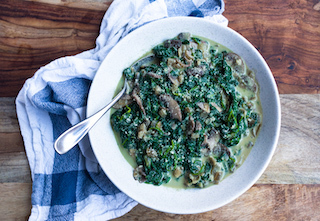 The creamed spinach many of us grew up with was too often overdone and underwhelming. It’s a genuine shame because spinach can and should retain its bright and distinct taste in the final dish as well as texture. In this recipe, you’ll find both. Sauteed mushrooms and shallots add nuance to what remains full, fresh flavor.
The creamed spinach many of us grew up with was too often overdone and underwhelming. It’s a genuine shame because spinach can and should retain its bright and distinct taste in the final dish as well as texture. In this recipe, you’ll find both. Sauteed mushrooms and shallots add nuance to what remains full, fresh flavor.
We’ve used coconut cream here, but use regular dairy or any non-dairy cream you prefer. Serving suggestion: Top with some parmesan, Parmigiano-Reggiano or pecorino at the end for a nice finish. We love this with a juicy beef roast.
Ingredients:
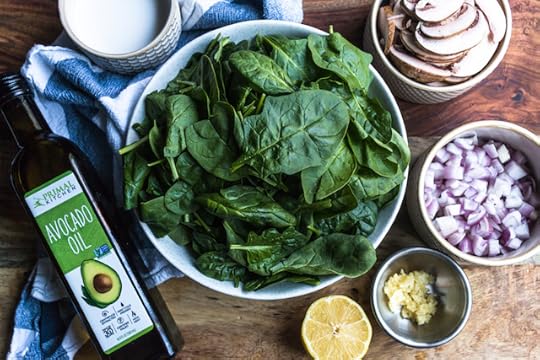
1 1/2 Tbsp. Primal Kitchen® Avocado Oil or butter
1/2 cup chopped shallots
2 cups sliced cremini mushrooms
5 cloves grated garlic
1 lb. baby spinach
½ cup coconut milk
2-3 tsp. coconut flour
½ tsp. salt
5 Tbsp. coconut cream
2 tsp. lemon juice
¼ tsp. black pepper
Optional: parmesan cheese
Instructions:
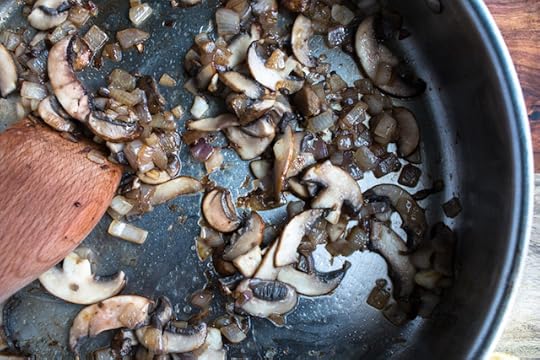
In a large pan, sauté the shallots in the avocado oil over medium heat for about 3 minutes. Once the shallots have softened, add the sliced mushrooms and a pinch of salt. Once the mushrooms begin to soften, mix in the garlic until it is fragrant. Add the spinach to the pan in batches, allowing the first batch to wilt before adding the next. Once the spinach is wilted, drain any excess liquid from the pan.

Add in the coconut milk, black pepper, coconut flour and another pinch of salt. Stir until combined and the coconut flour begins to thicken the sauce. Add in the coconut cream and lemon juice and stir until a sauce forms. If you’d like your sauce to be thicker, you can either remove the spinach from the pan and cook the sauce down, or place the pan into a 350 degree oven for about 10 minutes. Serve this creamed spinach with your favorite protein, like a nice steak or piece of chicken.
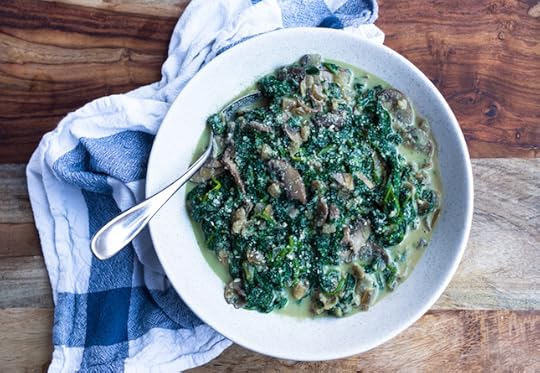
Nutrition Information (¼ of recipe):
Calories: 195
Total Carbs: 14 grams
Net Carbs: 10 grams
Fat: 14 grams
Protein: 5 grams

The post Creamed Spinach appeared first on Mark's Daily Apple.



November 22, 2019
Weekly Link Love — Edition 56

Research of the Week
Binge drinkers have a lower prefrontal cortical response to alcohol.
Implanting fecal matter from people with colon cancer into healthy rodents gives them precancerous lesions. Fecal transplants from people without colon cancer have no such effect.
Creatine may treat depression.
New Primal Blueprint Podcasts

Episode 390: Rob and Kendra Benson: Host Elle Russ hangs out with Rob and Kendra Benson, owners of Explorado Market, a keto grocery and bakery in Fort Collins, CO and creators of Fat Go Fit, the healthy keto energy packets and jars.

Primal Health Coach Radio, Episode 35: Laura and Erin chat with Barbell Physio’s Dr. Zach Long.
Each week, select Mark’s Daily Apple blog posts are prepared as Primal Blueprint Podcasts. Need to catch up on reading, but don’t have the time? Prefer to listen to articles while on the go? Check out the new blog post podcasts below, and subscribe to the Primal Blueprint Podcast here so you never miss an episode.
Media, Schmedia
Once again, waiting for the authorities to “do something” is not the answer.
The controversial chemist behind the BALCO scandal is reinventing himself as the “ketone guy.”
Interesting Blog Posts
Baleni salt sounds downright magical.
Social Notes
“Good enough.”
Everything Else
Close your eyes and listen to this talk on plant toxins and you’ll think that Jeff Goldblum is the newest carnivore convert.
“In areas where bison graze, plants contain 50 to 90 percent more nutrients by the end of the summer.”
Things I’m Up to and Interested In
Podcast I loved doing: The Ready State, with the inimitable Kelly and Juliet Starrett.
Blog post I found interesting: Did “Why We Sleep” overstate the benefits of sleep and drawbacks of inadequate sleep?
Article I found interesting: The universality of music.
This is quite the fact: 90% of what cattle eat is inedible to humans.
Video I enjoyed: Amy Berger on reacting to red meat studies.
Question I’m Asking
Can babies learn to love vegetables? How important are they?
Recipe Corner
Thanksgiving spread from Nom Nom Paleo.
A nice stuffing alternative in Brussels sprouts and butternut squash (cauliflower) rice pilaf.
Time Capsule
One year ago (Nov 16– Nov 22)
Happy Thanksgiving! – Thank you all.
Intermittent Fasting (and Feasting) at the Holidays: 6 Ways to Do It– How to work around holiday gluttony.
Comment of the Week
“Growing gardens? Going to the local market? Teaching kids to cook? Preparing homemade, real food for a family? Sounds like the job description of most every mom or grandma until a couple generations ago. ‘Hm,’ says the society with skyrocketing rates of childhood obesity and chronic disease, desperately scrambling to implement expensive government programs that repeatedly fail to solve any problems, ‘Maybe traditional women’s work was less meaningless and retrograde than we thought…'”
– Really makes you think, Erika.

The post Weekly Link Love — Edition 56 appeared first on Mark's Daily Apple.



Weekly Link Love — Episode 56

Research of the Week
Binge drinkers have a lower prefrontal cortical response to alcohol.
Implanting fecal matter from people with colon cancer into healthy rodents gives them precancerous lesions. Fecal transplants from people without colon cancer have no such effect.
Creatine may treat depression.
New Primal Blueprint Podcasts

Episode 390: Rob and Kendra Benson: Host Elle Russ hangs out with Rob and Kendra Benson, owners of Explorado Market, a keto grocery and bakery in Fort Collins, CO and creators of Fat Go Fit, the healthy keto energy packets and jars.

Primal Health Coach Radio, Episode 35: Laura and Erin chat with Barbell Physio’s Dr. Zach Long.
Each week, select Mark’s Daily Apple blog posts are prepared as Primal Blueprint Podcasts. Need to catch up on reading, but don’t have the time? Prefer to listen to articles while on the go? Check out the new blog post podcasts below, and subscribe to the Primal Blueprint Podcast here so you never miss an episode.
Media, Schmedia
Once again, waiting for the authorities to “do something” is not the answer.
The controversial chemist behind the BALCO scandal is reinventing himself as the “ketone guy.”
Interesting Blog Posts
Baleni salt sounds downright magical.
Social Notes
“Good enough.”
Everything Else
Close your eyes and listen to this talk on plant toxins and you’ll think that Jeff Goldblum is the newest carnivore convert.
“In areas where bison graze, plants contain 50 to 90 percent more nutrients by the end of the summer.”
Things I’m Up to and Interested In
Podcast I loved doing: The Ready State, with the inimitable Kelly and Juliet Starrett.
Blog post I found interesting: Did “Why We Sleep” overstate the benefits of sleep and drawbacks of inadequate sleep?
Article I found interesting: The universality of music.
This is quite the fact: 90% of what cattle eat is inedible to humans.
Video I enjoyed: Amy Berger on reacting to red meat studies.
Question I’m Asking
Can babies learn to love vegetables? How important are they?
Recipe Corner
Thanksgiving spread from Nom Nom Paleo.
A nice stuffing alternative in Brussels sprouts and butternut squash (cauliflower) rice pilaf.
Time Capsule
One year ago (Nov 16– Nov 22)
Happy Thanksgiving! – Thank you all.
Intermittent Fasting (and Feasting) at the Holidays: 6 Ways to Do It– How to work around holiday gluttony.
Comment of the Week
“Growing gardens? Going to the local market? Teaching kids to cook? Preparing homemade, real food for a family? Sounds like the job description of most every mom or grandma until a couple generations ago. ‘Hm,’ says the society with skyrocketing rates of childhood obesity and chronic disease, desperately scrambling to implement expensive government programs that repeatedly fail to solve any problems, ‘Maybe traditional women’s work was less meaningless and retrograde than we thought…'”
– Really makes you think, Erika.

The post Weekly Link Love — Episode 56 appeared first on Mark's Daily Apple.



November 21, 2019
Dear Mark: Synthetic Peptides
 For today’s edition of Dear Mark, I’m answering one question from a reader. It’s all about synthetic peptides, small chains of amino acids with potentially huge effects on your health and physiological function. In most cases, these synthetic peptides are based on naturally-occurring compounds found in the human body. Scientists isolate the “active component” of the compound and whip it up in a lab by stringing together the right amino acids. Many of these peptides are available for purchase online, strictly “for research purposes.” But people are using them.
For today’s edition of Dear Mark, I’m answering one question from a reader. It’s all about synthetic peptides, small chains of amino acids with potentially huge effects on your health and physiological function. In most cases, these synthetic peptides are based on naturally-occurring compounds found in the human body. Scientists isolate the “active component” of the compound and whip it up in a lab by stringing together the right amino acids. Many of these peptides are available for purchase online, strictly “for research purposes.” But people are using them.
Are these safe for humans? Are they effective?
Mark, I would love if you did a write-up on BPC-157 and LL-37 with regards to gut health. I’m surprised with all your articles on collagen peptides you haven’t written once about “synthetic” peptides. Thanks!
Sure.
Let Me Cover PBC-157 First….
BPC-157 is a partial reconstruction of a string of 15 amino acids that’s already found in Body Protection Compound, a naturally occurring healing compound the body produces. Its creators took the natural BPC and figured out the most “biologically active” section of its amino acid chain, then synthesized that section alone. You can find the real thing in human stomach juice (and presumably throughout the body doing its job). You can buy the synthetic version online.
What Does BPC-157 Allegedly Do?
It enhances healing and recovery from injury. In one study, BPC-157-treated Achilles’ tendon tissues were more resistant to injury, spread more quickly on a petri dish, and recovered faster than untreated tendon tissues.
In another rat study, their cecums—the beginning of the large intestine—were perforated. Applying BPC-157 enhanced healing, stopped bleeding, and sped up recovery.
It counteracts NSAID toxicity. BPC-157 blocks aspirin-induced bleeding and improves healing of NSAID-mediated lesions in the gut, brain, and liver.
Another rat study even used BPC-157 to improve healing from a spinal cord injury. BPC rats regained functional autonomy, had better control over their tails, and were less spastic.
It can treat periodontal disease, reversing inflammation and reducing bone loss.
It can treat colitis, reducing gut inflammation and restoring mucosal integrity.
Briefly looking through all the anecdotes online, most people are using this peptide to heal joint or tissue injuries, which seems to be the best use. Ben Greenfield swears it healed his tennis elbow and hamstring damage. I even saw one person who used it to improve brain health and function after years of stimulant abuse. Some research does show that BPC-157 can restore dopaminergic function in the brain. Some are even reporting restored sensitivity to stimulants (although using a healing peptide just to restore your ability to get high off Adderall again seems counterproductive).
What Are the Downsides?
It must be subcutaneously injected for maximal efficacy. This isn’t as hard as it looks (millions of diabetics do it every day) but some people are really nervous around needles. Orally-active BPC-157 is available, but I’m not sure how it compares.
There is the small problem of the total lack of published human studies. If there are any, I didn’t see them. The animal studies are impressive, though, and the fact that the peptide chain does naturally occur in our bodies suggests it’s relatively safe, but we don’t know for sure.
A big problem is that you can’t verify the purity of the products available online. You have to read reviews, know the right people, and do the research. These aren’t legally intended for human consumption, so there’s no testing authority regulating the safety and content of these products.
Now For LL-37….
LL-37 is an anti-microbial peptide found naturally in people. It’s heavily involved in the immune response, and its role in health isn’t very clear. It isn’t consistently “good” or “bad.” For instance, its presence can suppress tumor growth in colon and gastric cancer, but it’s been shown to promote tumor growth in ovarian, lung, and breast cancers. But it’s also able to bind to and negate the effects of lipopolysaccharide, the bacterial endotoxin secreted by many gut pathogens, and selectively target apoptotic white blood cells while leaving viable ones unaffected.
Why Are People Using It?
There are online forums populated by people who are using this peptide to heal gut issues, deal with inflammatory diseases, and treat autoimmunity—or, they’re at least buying the peptide, injecting it, and hoping that it works and not always following up with the results. I’m skeptical about using these as justification to experiment. As one recent paper put it, LL-37 is a tiny peptide with huge effects:
Some of the functions of LL-37 are anti-inflammatory, particularly those involved in blocking Gram-negative signaling pathways through TLR4. However, in the context of the inflammatory response, this peptide may also provide proinflammatory signals that can propagate inflammation, stimulate type I IFN production, and result in induction of autoimmune diseases. Further research is needed to fully understand the big effects of this little peptide on immune system function so that potential therapeutic uses can be explored.
Sticking Points With LL-37
Much of this could be a guilt by association situation: LL-37 is often found elevated at disease sites and in diseases states because it’s part of the inflammatory response. It isn’t necessarily causing the disease. But the immune response is a delicate one with huge ramifications. I’d be very careful with injecting a peptide that the body normally produces in times of acute inflammation. That sounds a lot like trying to attempt top-down regulation of innate immunity—a decidedly bottoms-up process. Probably better to wait for human trials rather than rely on positive anecdotes from unsourced forum posts. I’m not saying these people aren’t helping themselves with this compound. I’m saying the risk of complications or unwanted effects would be too high for me.
That’s it for today, folks. Thanks for reading and be sure to comment down below. Do you have any experience using these synthetic peptides? How about any others?

The post Dear Mark: Synthetic Peptides appeared first on Mark's Daily Apple.



Mark Sisson's Blog
- Mark Sisson's profile
- 199 followers


